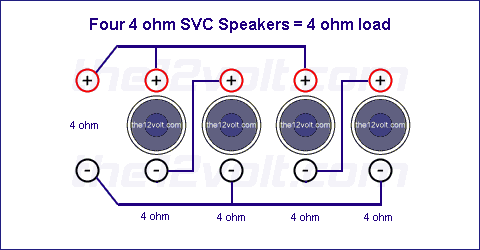Ok I use the parallel calc on this forum but I am concern.
I always thought the following:
Parallel
1. 4ohm +4ohm+4ohm+4ohm= 1ohm
2. 8ohm+8ohm= 4ohm
Is this not correct.
According to the calc on this forum it show a 1.3ohm load for #2
And what I am trying to do is to run 4 4ohm subs in a 4 ohm load. Is this possible or not.
Example:
Series:
4ohm+4ohm = 8ohm x 2 sets
Then parallel the 2 set of subs to bring it back to a 4ohm load. Is this possible?
Thanks Chad
Using the woofer wiring wizard, 4 X 4-ohm SVC @ 4-ohms net:

-------------
Support the12volt.comchadpcb - FYI, your calcs are correct.
Series resistance is simple - add all the resistances. (Same for inductors, but NOT capacitors - that is the parallel capacitance formula.)
Parallel is trickier - the total resistance is "the reciprocal of {the sum of individual reciprocals}" ie, R = 1/(1/R1 + 1/R2 + 1/R3 + ....).
For 2 parallel resistors, that reduces to (R1 + R2)/(R1 x R2).
For parallel resistors that are all the same value, eg - a number n of R-Ohm resistors - it reduces to R/n.
(The above is the same for parallel inductors, and SERIES connected capacitors.)
In DYohn's pic it is 2 sets of series 4Ω in parallel - ie, (4+4)//(4+4) = 8//8 = 8x8/(8+8) = 64/16 = 4Ω (where I am using "//" to mean "in parallel with" whereas "/" means the usual "divided by.) (And x = * = multiplied by.)
I recall the 1.3ohm (or similar) that you mention and I too was miffed, but I assumed it had to do with the particular outputs for that amplifier, and the mixed(?) resistance speakers used).
